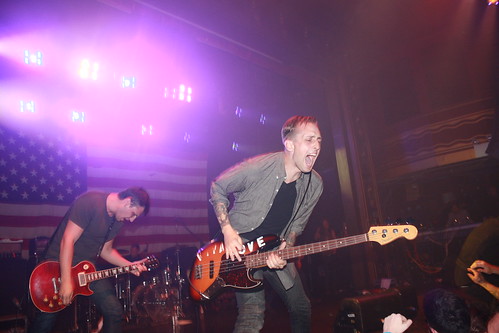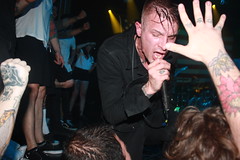Two weeks after members of the Cro-Mags were allegedly stabbed by the band’s former bassist, hardcore returned to Webster Hall as Give Up the Ghost performed a pair of sold-out shows.
The Boston band (still known to many as American Nightmare or A.N., though a copyright suit forced them to change the name in 2002) kept Webster Hall’s bouncers on their toes Friday and Saturday. “Things were a little tighter security-wise,” said guitarist Brian Masek. “Hardcore isn’t always violent, but it’s dark, aggressive music, so it brings out a certain element.”
Indeed, the mosh pit was hundreds strong as vocalist Wes Eisold, who also leads synth-goth act Cold Cave, belted out the honest, poetic lyrics that have inspired a generation of tattooed hardcore kids.
American Nightmare formed in 1999 during a time when Mission Hill, a neighborhood bordering Northeastern University and Massachusetts College of Art and Design, had replaced the Lower East Side as the capital of hardcore. Unlike New York, the Boston scene consisted mostly of suburban transplants, but the two scenes shared one thing in common: violence.
In an essay about American Nightmare and the environment it emerged from, Anthony Pappalardo, a former hardcore musician who is now an editor at Vice, wrote, “I wondered as a teen why all the popular positive straight edge bands were from southern California or suburban Connecticut, while Boston had only grumpy old Slapshot. It didn’t hit me until I moved there for college along with about four million other 18 year-olds. Forget about a harmonious hardcore scene, this was a city that didn’t even welcome pop-punk as evidenced by a 100,000-person riot at a free Green Day show in 1994.”
Gangs like FSU (polite version: Friends Stand United) and BBC (Brockton Brooklyn Connection) feuded and bonded with their New York counterparts DMS. Fights were often mismatched beatdowns or all-out brawls between crews. Pool balls in socks, called “madballs,” were the weapon of choice along with brass knuckles, chairs, bottles, skateboards, lamps and fans. This reporter once watched a member of FSU use a madball to beat a moving vehicle to a standstill, after which he smashed its windows and then its passengers.
The founder of FSU, Elgin “Nathan” James, was just released from federal prison after an extortion conviction stemming from a 2005 incident. According to an FBI press release, “James allegedly told the victim that James could resolve the victim’s dispute with FSU if the victim made a payment to James; otherwise, FSU members would continue to attack the victim as the victim traveled throughout the country.” Mr. James is also a rising screenwriter-driector mentored by Robert Redford, who wrote a letter of support at the time of his sentencing.
The romantic myth of violence is exactly what draws angry youth to hardcore, but it’s also why bands like the Cro-Mags and American Nightmare have never been able to sell as many tickets as, say, the emo band My Chemical Romance, which once opened for American Nightmare. Violent, hateful people keep hardcore permanently underground.
Still, a mythology has developed around Give Up the Ghost/American Nightmare since the band’s breakup in 2004: in re-forming to play a handful of shows, it has gone from 300-capacity venues to selling 3,000 tickets this past weekend. “The last place we played [in New York] was CBGBs,” Mr. Masek said, “which was pretty much the only place we played in New York. We did one show at the Knitting Factory but were promptly banned after a fight broke out during our set.”
As Friday’s show began, an American flag was the only thing visible on the darkened stage. Feedback buzzed, and then the crowd exploded into frantic stage diving and slam-dancing. Sweat-drenched fans screamed along with lyrics about lost love. Mr. Eisold, meanwhile, didn’t say a word to the crowd the entire set.
Security guards at the show declined to divulge details about the CBGB Festival stabbing. “You mean the little guy waving the knife around?” laughed a bouncer posted at the backstage door. “We do hip-hop on Thursdays: come when Jadakiss is performing and you’ll see real thugs.”
Meanwhile, followers of hardcore continue to debate what exactly happened at Webster Hall on the night of July 6. One musician who toured separately with both Mr. Flanagan and current Cro-Mags singer John Joseph McGowan (he declined to be named, for fear of retribution) said there was a better chance of finding out who killed Kennedy.
Mr. Flanagan, who faces charges of assault and criminal weapons possession, continues to maintain that he was jumped by members of DMS. “If they were a real gang they’d be fighting other real gangs, not jumping people ten-on-one at hardcore and punk rock shows,” he wrote in a text message. “They are cowards.”
And so the cycle continues.





